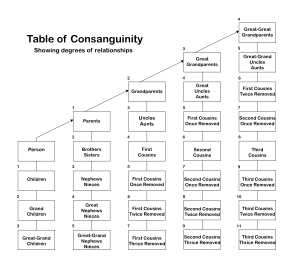| Relationship | Average DNA
shared % |
|---|
| individual-self | 100% |
| mother / father / daughter / son | 50% |
| half-sister / half-brother | 25% |
| sister / brother | 50% |
| grandmother / grandfather / granddaughter / grandson | 25% |
| half-aunt / half-uncle / half-niece / half-nephew | 12.5% |
| aunt / uncle / niece / nephew | 25% |
| half-first-cousin | 6.25% |
| first-cousin | 12.5% |
| irregular-double-cousin | 18.75% |
| double-first-cousin | 25% |
| great-grandmother / great-grandfather / great-granddaughter / great-grandson | 12.5% |
| half-grandaunt / half-granduncle / half-grandniece / half-grandnephew | 6.25% |
| grandaunt / granduncle / grandniece / grandnephew | 12.5% |
| half-first-cousin-once-removed | 3.125% |
| first-cousin-once-removed | 6.25% |
| irregular-double-first-cousin-once-removed | 9.375% |
| double-first-cousin-once-removed | 12.5% |
| half-second-cousin | 1.5625% |
| second-cousin | 3.125% |
| irregular-double-second-cousin | 4.6875% |
| double-second-cousin | 6.25% |
| irregular-triple-second-cousin | 7.8125% |
| triple-second-cousin | 9.375% |
| irregular-quadruple-second-cousin | 10.9375% |
| quadruple-second-cousin | 12.5% |
| great-great-grandmother / great-great-grandfather / great-great-granddaughter / great-great-grandson | 6.25% |
| half-great-grandaunt / half-great-granduncle / half-great-grandniece / half-great-grandnephew | 3.125% |
| great-grandaunt / great-granduncle / great-grandniece / great-grandnephew | 6.25% |
| half-first-cousin-twice-removed | 1.5625% |
| first-cousin-twice-removed | 3.125% |
| irregular-double-first-cousin-twice-removed | 4.6875% |
| double-first-cousin-twice-removed | 6.25% |
| half-second-cousin-once-removed | 0.78125% |
| second-cousin-once-removed | 1.5625% |
| irregular-double-second-cousin-once-removed | 2.34375% |
| double-second-cousin-once-removed | 3.125% |
| irregular-triple-second-cousin-once-removed | 3.90625% |
| triple-second-cousin-once-removed | 4.6875% |
| irregular-quadruple-second-cousin-once-removed | 5.46875% |
| quadruple-second-cousin-once-removed | 6.25% |
| half-third-cousin | 0.390625% |
| third-cousin | 0.78125% |
| irregular-double-third-cousin | 1.171875% |
| double-third-cousin | 1.5625% |
| irregular-triple-third-cousin | 1.953125% |
| triple-third-cousin | 2.34375% |
| irregular-quadruple-third-cousin | 2.734375% |
| quadruple-third-cousin | 3.125% |
| irregular-quintuple-third-cousin | 3.515625% |
| quintuple-third-cousin | 3.90625% |
| irregular-sextuple-third-cousin | 4.296875% |
| sextuple-third-cousin | 4.6875% |
| irregular-septuple-third-cousin | 5.078125% |
| septuple-third-cousin | 5.46875% |
| irregular-octuple-third-cousin | 5.859375% |
| octuple-third-cousin | 6.25% |
| great-great-great-grandmother / great-great-great-grandfather / great-great-great-granddaughter / great-great-great-grandson | 3.125% |
| half-great-great-grandaunt / half-great-great-granduncle / half-great-great-grandniece / half-great-great-grandnephew | 1.5625% |
| great-great-grandaunt / great-great-granduncle / great-great-grandniece / great-great-grandnephew | 3.125% |
| half-first-cousin-thrice-removed | 0.78125% |
| first-cousin-thrice-removed | 1.5625% |
| irregular-double-first-cousin-thrice-removed | 2.34375% |
| double-first-cousin-thrice-removed | 3.125% |
| half-second-cousin-twice-removed | 0.390625% |
| second-cousin-twice-removed | 0.78125% |
| irregular-double-second-cousin-twice-removed | 1.171875% |
| double-second-cousin-twice-removed | 1.5625% |
| irregular-triple-second-cousin-twice-removed | 1.953125% |
| triple-second-cousin-twice-removed | 2.34375% |
| irregular-quadruple-second-cousin-twice-removed | 2.734375% |
| quadruple-second-cousin-twice-removed | 3.125% |
| half-third-cousin-once-removed | 0.1953125% |
| third-cousin-once-removed | 0.390625% |
| irregular-double-third-cousin-once-removed | 0.5859375% |
| double-third-cousin-once-removed | 0.78125% |
| irregular-triple-third-cousin-once-removed | 0.9765625% |
| triple-third-cousin-once-removed | 1.171875% |
| irregular-quadruple-third-cousin-once-removed | 1.3671875% |
| quadruple-third-cousin-once-removed | 1.5625% |
| irregular-quintuple-third-cousin-once-removed | 1.7578125% |
| quintuple-third-cousin-once-removed | 1.953125% |
| irregular-sextuple-third-cousin-once-removed | 2.1484375% |
| sextuple-third-cousin-once-removed | 2.34375% |
| irregular-septuple-third-cousin-once-removed | 2.5390625% |
| septuple-third-cousin-once-removed | 2.734375% |
| irregular-octuple-third-cousin-once-removed | 2.9296875% |
| octuple-third-cousin-once-removed | 3.125% |
| half-fourth-cousin | 0.09765625% |
| fourth-cousin | 0.1953125% |
| irregular-double-fourth-cousin | 0.29296875% |
| double-fourth-cousin | 0.390625% |
| irregular-triple-fourth-cousin | 0.48828125% |
| triple-fourth-cousin | 0.5859375% |
| irregular-quadruple-fourth-cousin | 0.68359375% |
| quadruple-fourth-cousin | 0.78125% |
| irregular-quintuple-fourth-cousin | 0.87890625% |
| quintuple-fourth-cousin | 0.9765625% |
| irregular-sextuple-fourth-cousin | 1.07421875% |
| sextuple-fourth-cousin | 1.171875% |
| irregular-septuple-fourth-cousin | 1.26953125% |
| septuple-fourth-cousin | 1.3671875% |
| irregular-octuple-fourth-cousin | 1.46484375% |
| octuple-fourth-cousin | 1.5625% |
| irregular-nonuple-fourth-cousin | 1.66015625% |
| nonuple-fourth-cousin | 1.7578125% |
| irregular-decuple-fourth-cousin | 1.85546875% |
| decuple-fourth-cousin | 1.953125% |
| irregular-undecuple-fourth-cousin | 2.05078125% |
| undecuple-fourth-cousin | 2.1484375% |
| irregular-duodecuple-fourth-cousin | 2.24609375% |
| duodecuple-fourth-cousin | 2.34375% |
| irregular-tredecuple-fourth-cousin | 2.44140625% |
| tredecuple-fourth-cousin | 2.5390625% |
| irregular-quattuordecuple-fourth-cousin | 2.63671875% |
| quattuordecuple-fourth-cousin | 2.734375% |
| irregular-quindecuple-fourth-cousin | 2.83203125% |
| quindecuple-fourth-cousin | 2.9296875% |
| irregular-sexdecuple-fourth-cousin | 3.02734375% |
| sexdecuple-fourth-cousin | 3.125% |











